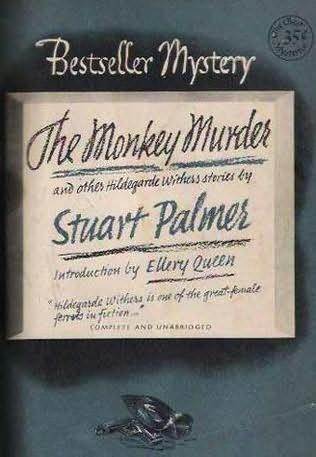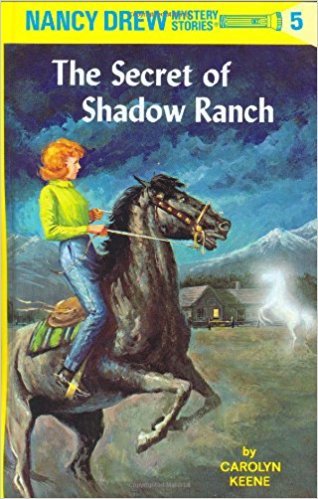In case you aren’t familiar with American writer Stuart Palmer, he is a prolific mystery author and screenwriter. Palmer was also an accomplished writer of ghost stories. Stuart Palmer’s amateur sleuth, Hildegarde Withers, appears in fourteen complete-length novels and many short stories. She’s a variation on the more popular Miss Marple but comes with many charms in her mysteries. A school teacher who collects tropical fish, she’s well known for her prudish ways and irritable attitude. You can learn about her further in today’s Short Story Saturday: The Monkey Murder by Stuart Palmer, found in Golden Age Detective Stories, edited by Otto Penzler.
The Players
- George Wayland: A mild-mannered man who Police Inspector Oscar Piper is convinced killed his wife.
- Janet Wayland: George Wayland’s wife was found dead in a locked room under bizarre circumstances.
- Oscar Piper: An investigator in the New York Police Department’s homicide department tasked with figuring out who killed Janet Wayland.
- Miss Hildegarde Withers: A middle-aged school teacher from Boston who often helps Oscar Piper solve crimes.
- Inga Rasmussen: George Wayland’s ex-lover.
- Lieutenant Bartz: A lieutenant in the New York Police Department. Engaged to Inga Rasmussen.
The Mystery
The story begins with an intriguing premise: George Wayland finds his wife, Janet Wayland, dead in a locked room. She was found tied up with the tail of a Monkey statue wrapped around her neck in a staged killing.
New York City police detective, Oscar Piper, knows George Wayland killed her but cannot prove it. When Oscar Piper and Hildegaard Withers run into George Wayland on the street, Oscar Piper enlists the help of Hildegarde Withers to catch this brazen killer.
To gain access to George Wayland, Miss Hildegarde Withers poses as a prospective buyer of George Wayland’s house, which he wants to sell after the tragic death of his wife, and tours the place to look for clues. George Wayland shows her the bedroom where his wife was murdered and the smashed door, which broke down to get to her. As they descend onto the basement, Hildegarde Withers feels frightened that George Rasmussen knows her identity. George Wayland shows Hildegarde Withers his wife’s personal effects, including clothes and sundries. Hildegarde Withers notices a large stack of pulp fiction stories on a shelf in the basement and makes a mental note of the titles.
As Hildegarde Withers leaves, George Wayland confronts her, confirming he knows who she is and that she’s investigating him for murdering his wife. George Wayland, smug and self-assured, laughs cruelly in her face before shutting the door.
Hildegarde Withers tracks down George Wayland’s secretary, Inga Rasmussen, at her apartment to discern a motive for the bizarre crime. Inga Rasmussen, newly arrived from Sweden, insists that she knows nothing about the crime. She admits that she went on a few dates with George Wayland before discovering that he was married but broke off their relationship. Inga Rasmussen tries to conceal that she has a visitor in her apartment but is given away by a smear of lipstick on her earlobe. Sheepishly calls to her bedroom, and out steps Lieutenant Bartz of the New York Police Department. Breathlessly, Inga Rasmussen says that she needs Janet Wayland’s murder to be solved so they can marry.
Hildegarde Withers, suspicious of this romantic assignation, bids farewell to the couple but is quickly joined by Inga Rasmussen, who wants to pick up a gelato from a place down the street.
A week passes, and Hildegarde Withers contacts Oscar Piper, who is soon to be embarrassed in the press by a story detailing his failures in solving the case, and tells him she’s cracked the case.
The Motive
The motive in this story is clearly stated, Inga Rasmussen and George Wayland want to continue their romantic relationship. Despite the reveal of Inga Rasmussen’s new relationship, none of the other characters believe in her new love affair, making it nearly impossible for the reader to believe her.
The Verdict
The unbelievability of the alibi is one of the significant problems in this paper-thin story. It’s inconceivable that a trained investigator would be unable to interview Inga Rasmussen and break her story, but that pales in comparison to several other plot issues. The central conceit that only Hildegarde Withers can worm her way into the killer’s habitat unnoticed, making her more valuable than a trained investigator, is proved false within the story’s text. George Wayland knows Hildegarde Withers is only at his house to investigate him and then taunts her to do so. Hildegarde Withers’s barebones investigation of reading through pulp fiction stories and that she saw walking through the house is such an easy task that any New York City beat cop could do it. Whatever other investigating she does, is obliterated by a time jump and the reveal that she figured it out –without the reader.
The initial premise of using a monkey statue for the murder is quickly dropped, and the resolution is unsatisfactory. George Wayland and Inga Rasmussen are exciting characters, but without evidence that someone else could have been the killer, the reader is forced to conclude that they must be the murderers. I won’t spoil how they did it and will concede there is a twist at the end, but it’s too late to redeem the story.
The Monkey Murder by Stuart Palmer is a messy short story that will be a contender on my worst list of 2023. Only some of the stories, books, media, and products reviewed on this blog will succeed in their aims, giving us something to discuss.
You can read The Monkey Murder here: https://amzn.to/3icOXFU

Pre-order the first book in the Hildegarde Withers series, The Penguin Pool Murder https://amzn.to/3G7KsV
which will be released on January 17, 2023.
Stay tuned for a review of The Penguin Pool Murder to be released on The Golden Age of Detective Fiction on January 17, 2023.





Leave a comment